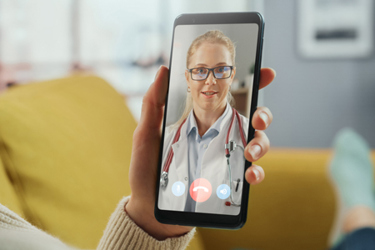Telehealth In 2025 And Beyond: The Future Is Bright
By Dan Cohen, Adhere+

The rapid evolution of telehealth is transforming how patients access — and physicians provide — care, a shift accelerated by policy changes adopted during the COVID-19 pandemic. The announcement in January 2025 of the DEA’s three new rules regarding the remote prescribing of controlled substances marks a critical moment in this evolution. These rules seek to balance the promise of remote access to care — expanding treatment options for rural, vulnerable, and underserved populations — with the challenges of cost, compliance, and security.
Traditional in-person visits and patient portals provide only brief, periodic snapshots of a patient’s condition, making it difficult for providers to track long-term progress or detect inconsistencies in reported symptoms. Without continuous insights, treatment decisions are often based on limited, subjective patient input rather than a full picture of how a patient responds to therapy over time. As telehealth adoption grows, regulatory frameworks are evolving to ensure both accessibility and compliance, particularly for controlled substance prescribing.
The New Regulatory Landscape
The DEA’s proposed new rules reflect the need to strike a balance between ensuring effective access to necessary medications while preserving the ability to prevent or limit misuse or diversion. While these policies are designed to expand prescribing options, they also introduce important compliance requirements, such as state registrations, prescription drug monitoring programs (PDMPs) checks, and electronic prescriptions. In this evolving landscape, telehealth plays a crucial role in enabling providers to meet these requirements by automatically documenting actions without adding excessive administrative burdens.
For chronic care patients on Schedule II medications, telehealth helps providers demonstrate compliance by documenting patient interactions over time and capturing objective data through digital tools. This ongoing data collection also ensures that treatment decisions are based on a more complete understanding of patient behavior rather than single point-in-time interactions.
Technology As A Solution
Unlike e-visits, which require patients to be present for a live video (telemedicine) consultation, telehealth operates asynchronously. Patients engage with providers through digital tools, such as remote therapeutic monitoring (RTM) platforms that collect ePROs (electronic patient reported outcomes) daily, rather than during a single scheduled interaction. Because patients interact with telehealth tools daily, rather than in a single monthly or less frequent in-person appointment, the tracked and trended data often provides a more revealing picture. This shift allows providers to stretch and amplify the impact of their otherwise brief encounters, turning isolated touchpoints into a continuous stream of clinical patient insights.
A critical challenge in pain management and other chronic treatment conditions is determining how adherent a patient is to prescribed treatment and how compliant the patient is with prescribed therapy. In a traditional setting, providers often rely on brief, in-person evaluation and management (E/M) visits where patients often either downplay or exaggerate their symptoms. Telehealth’s asynchronous approach via a nonjudgmental telephonic device changes this dynamic, allowing for more candid patient engagement. Telehealth provides a clearer, more accurate “real-time, real-world” picture of patient health, helping to differentiate those in need of increased medical intervention, those doing well, and even from those who may be missing or misusing prescribed treatments.
Some physicians believe that patient ePRO data may be more honest in reporting symptoms to an app than directly to a provider, making long-term data collection more reflective of their true experience. Patients may feel less pressure reporting symptoms in a digital format than when speaking face-to-face with a provider, making the data collected over time more accurate, less influenced by social pressures, and better suited to capturing patterns of pain or medication adherence.
Over time, this data can act as a barometer, offering a clearer picture of which patients may be underreporting their pain or other complications and require adjustments to their medication or care plan regimens, as well as those with reported clinical symptoms that may not align with clinical assessments. This insight helps physicians better distinguish between patients who need increased medication for legitimate reasons and those at risk of misuse.
The ability to track patient behavior over time not only improves treatment precision but also strengthens the documentation supporting a physician’s prescribing decisions. By leveraging telehealth-driven ePROs data, providers can move beyond episodic one-time assessments and develop a more nuanced evidence-based approach to patient care.
Addressing Cost And Adoption Challenges
One of the biggest barriers to telehealth adoption is ensuring that it remains both affordable for patients and sustainable for providers. Historically, reimbursement models for telehealth have been cumbersome, with some requiring multiple interactions over a short period to justify billing — an impractical approach for high-volume providers.
To address this, newer telehealth solutions are being designed to seamlessly capture and log billable interactions, automating documentation to streamline reimbursement and help demonstrate compliance. This shift ensures that physicians can integrate telehealth into their existing workflows without increasing administrative overhead or disrupting care delivery.
In fields such as pain management, fibromyalgia, and rheumatoid arthritis — where in-person visits alone may not fully capture the patient’s experience — telehealth provides a scalable way to track and adjust treatment plans without overwhelming providers with additional administrative burdens.
A Data-Driven Approach To Better Care
Perhaps the greatest value of continuous telehealth interactions is that they validate clinical decisions and create transparency in treatment protocols. By transforming episodic encounters into an ongoing care process, telehealth generates a comprehensive data set that allows providers to make better-informed decisions, proactively adjust treatment plans to improve outcomes and limit adverse events, and ensure adherence to regulatory and compliance standards.
This shift represents a fundamental change in how care is delivered. Instead of relying solely on single scheduled interactions, providers can now monitor patients through many moments, across many data points, over time. This creates a more comprehensive understanding of patient needs, allowing for earlier interventions, more personalized treatments, and better long-term health outcomes.
As asynchronous telehealth continues to evolve, its role in patient care will only expand. By reducing documentation burdens, improving data accuracy, and optimizing reimbursement models, telehealth is poised to become not just an alternative to in-person visits but a core pillar of modern healthcare.
About The Author:
 Dan Cohen, president and co-founder of Adhere+, has over 40 years of leadership experience in government, healthcare, and business. He has built and led successful startups that enhance medical technologies and improve patient outcomes. With expertise in finance, mergers, and product development, Cohen focuses on advancing remote therapeutic monitoring (RTM) solutions that help providers improve care plan adherence and compliance.
Dan Cohen, president and co-founder of Adhere+, has over 40 years of leadership experience in government, healthcare, and business. He has built and led successful startups that enhance medical technologies and improve patient outcomes. With expertise in finance, mergers, and product development, Cohen focuses on advancing remote therapeutic monitoring (RTM) solutions that help providers improve care plan adherence and compliance.
